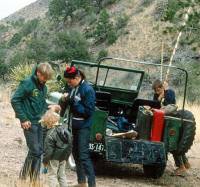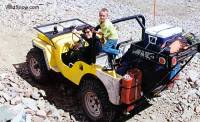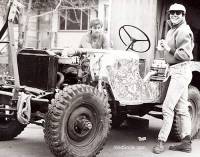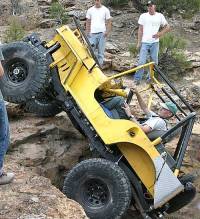
Rumble Bee is slightly under-built for the most extreme rock crawling, but where is the fun in having something that’ll walk over anything? This is Lou testing the Bee in Billings Canyon, near Grand Junction, Colorado. He bent the rear springs and broke the rear Lockright locker, since replaced the springs with a slightly stronger springpack, controlled by a traction bar, and replaced the Lockright with a Detroit Locker. All tested in Moab and given a clean bill of health — though Billings might still be a little much without excessive winching.
It’s said you ride “on” rather than “in” the old CJ2A Willys flat fender Jeeps. True, you ride “on” the gas tank (it’s under the seat), but driving “in” a flattie must be the closest thing to being shoehorned into a space capsule that most of us will ever experience. It’s impossible to straighten out a leg, your hands might hit the windshield if you grip the steering wheel wrong — and you can reach out and touch the front left tire. In all, an uncomfortable but strangely exhilarating experience.
What that cramped space gets you is an 80 inch wheelbase — fully out of style (rock and ledge crawling has driven the trend to longer 4x4s), but still fun to drive, exciting and tippy on occasion, and sometimes even an advantage.
As many have done before us, we bought our 1947 “flattie” as a drivable but trashed Jeep for an even $1,000 — the going rate for a junker Willys in 1992. Yet before that momentous occasion, Jeeping had a long history in our family.
In Texas and Aspen during the 1960s I’d learned to drive in a flat fender Jeep (in those days a state-of-art off road vehicle). A few days after my first driving lessons, with both parents at work, my brother and I decided to see what that Jeep could do! We ripped turf all over our large rural Texas lot, bouncing through ditches and working the gears like Andretti worked his Lotus — at least in our own minds. After crawling the fields we set our eyes on the landscaping berms. They fell to teenage 4×4 power — at least until the largest one, where we high centered at the exact summit. We tried everything to budge that Jeep before our elders arrived. The Willys was still there when mom and dad got home, perched on that berm like an advertising parody. A delay in my driving lessons ensued.
We moved to Aspen, Colorado soon after that, and our family of six traveled all over the Colorado backcountry in that old rig, even rolling it once (with no serious injuries), and wearing out the motor to the point where we had to back it up steep hills so it could climb in the lower ratio reverse gear.
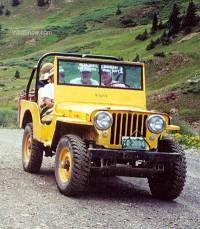
My uncle’s yellow Willys inspired us to obtain and “restore” our own. This is he and family wheeling near Crested Butte, Colorado.
Fast forward three decades. In 1995 my wife and I visit my uncle Frank in Crested Butte. He lends us his locally famous yellow flat fender CJ-2A and we take a romantic drive up near Pearl Pass. My wife utters the magic words “Let’s get a Jeep,” or, did she actually say “I love ….?” If memory serves it was the former, at least in my male neurons, but it could have been something more romantic.
Either case, before long I was shopping for a flat fender Willys Jeep, and pricing yellow Krylon. Yes, old Jeeps are like boats, a hole you throw money into, but pitching coin that direction is fun — especially if you do most of the work yourself.
Our ensuing 12-year restomod of “Rumble Bee” includes a huge amount of fun doing everything from backcountry skiing approaches to wheeling for it’s own sake, plentiful stupid and expensive decisions on my part, and a final result that retains the flat fender look and feel, while being competent and safe enough on the trail to peg the fun meter. This “retro” project includes little of the latest tech — it’s mostly older solutions that reached their peak a number of years ago, but it works.
Rumble Bee — Part 2 — The “Semi-Final” Product
It’s true, “Jeeps are never done.” Even so, the Bee is built to the point where we’re extremely happy. It can tackle the hardest trails with a bit of winching and the occasional obstacle bypass or rock stack, but still drive a safe and stable 58 mph on the pavement.
The long process of building this truck included one nearly complete disassembly and restoration, then another frame-off for an engine and transmission swap. In the beginning we were primarily interested in restoration, but I soon realized it was more fun to build for trail performance, while playing the game of cost and time vs. performance — along with keeping the Jeep looking like a flat fender instead of a rock buggy, and retaining some semblance of highway manners so we could use it as a grocery getter.
A big change in the project came when I began working for Chris Overacker as his CODE 4×4 webmaster. An acknowledged master of Jeeps, Chris has owned and resto-modified a flat fender, worked on scores more, and truly cares that his friends and customers have achievable goals.
Follow along for twelve years, starting with my rather amateurish attempts at building a Jeep, all they way up to my education by “Dr. Code” in the finer points of Jeep building:
First Restoration
It might have been a midlife crises, or simple obsession with things mechanical, but our first years of flattie ownership saw me out in the garage for many days off and late evenings, bashing and welding on the body tub, with the Bee in parts stowed in boxes and sheds. I didn’t have a clear goal in mind — just the desire for a reliable “Jeep” that was fun to drive around the Aspen area, and would handle the trails within reason.
I first met Chris Overacker during this stage of the project. My original frame was trashed. He owned Stage West 4×4 then, and I took him the frame with the intention of paying for a pro job of fixing. He took a quick look at the frame and informed me that it was much too tweaked and trashed, and that I should get a better quality used one — or buy a new one.
While I should have followed “Dr. Code’s” advice to buy a new frame, instead I located another original in a pile of Jeep parts a local guy had been accumulating for years. It was in better shape, but the front frame horns needed to be boxed — a job Chris did agree to do, and has held up for decades now.
We de-rusted the frame and painted it gloss black, then I pretty much took the Jeep back to stock, refurbishing or replacing each part as it went in, upgrading the drum brakes to 11-inch GM style grabbers, and laying a precision (hah) coat of rattle can yellow on the bodywork.
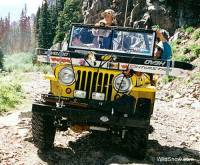
On the way to summer skiing in Montezuma Basin near Aspen. New motor is in, still running meager tires and axles but they work great for this moderate trail.
Let the Build-Up Begin
Rumble Bee was back together a few months after the first frame-off, and fun to drive around. But the old motor was tired and prone to overheating. I studied up on options, and realized that swapping in a modern 4-speed transmission, along with clutch and Chevrolet V-6, would be a much wiser way to have a decent power plant.
To do it right, I took the body off the frame again, and carefully fit a 229 V6 engine and clutch from a 1981 Chevrolet Malibu, mated to a rebuilt T-98 4 speed we bought fresh and new. We re-used the same tired transfer case, and added a Warn overdrive a few years later so we didn’t have to burn up the V6 trying to top 45 mph.
Axles — round 1
With our added power and gears, we were having too much fun on the trails. We were still using the original front and rear axle, and I’d been through the rear several times, trying to reliably secure the funky axle hubs that attached to the axle shafts using a taper and keyway. Having enough of that, I ordered up a Dana 44 rear axle with a locker and off we went, smoothly crawling terrain where before we would have been bashing and jerking, if not simply stuck. Fun stuff.
We still had smallish tires, so the vintage 1947 front axle did its job, though I did go through it and reinforce the spindle/hub bolts so they wouldn’t yank out when under a side load.
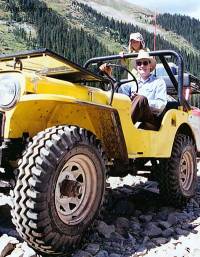
In the 1990s you could get ‘Grip Spur’ tall skinny tires that fit well to the stock CJ. They’re basically bias ply mud tires designed for farm equipment.
Tires — round 1
Our Willys came with classic Powermaster bias tires equivalent to about a 31 inch tall off-road tire. With such a short wheelbase, we had tons of fun with those tiny rollers. Nonetheless, with a decent rear axle and V6, I knew I could run taller meats and crawl bigger rocks. Trying to keep it simple, I drove a few blocks over to our Co-Op car center, and bought a set of 16-inch white spoke rims, mounted with four Grip Spur mud tires that measured equivalent to what we now call a “33 inch” tire.
While stiff and unforgiving, the Spurs worked well for Colorado scree and alpine gravel — conditions you find on most of our high altitude Jeep trails. More, they were cheap, and incredibly thick. Flats were not even a concept. We used these tires for years, and I still recommend them if you’re doing a moderate build-up and want a skinny aggressive tire with a cool “retro” look.
Miscellany
We also spent quite a bit of time on creature comforts. I built a security console that custom fit between the seats and locked with a big padlock, and fabricated a large “rally rack” that rides up high at the rear. (This ended up too large, so we downsized it in the next incarnation.) We were mostly happy with the Bee, but I still worried about the front axle breaking, it needed a better safety cage, better seats, and more. Thus, the final buildup ensued.
WildSnow.com publisher emeritus and founder Lou (Louis Dawson) has a 50+ years career in climbing, backcountry skiing and ski mountaineering. He was the first person in history to ski down all 54 Colorado 14,000-foot peaks, has authored numerous books about about backcountry skiing, and has skied from the summit of Denali in Alaska, North America’s highest mountain.

